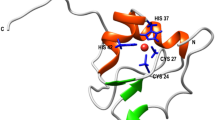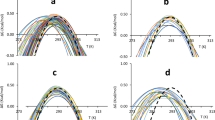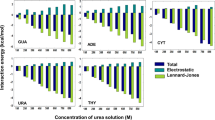Abstract
The reductive unfolding of ribonuclease A with dithiothreitol proceeds through parallel pathways with the formation of two well-populated partially-unfolded three-disulphide intermediates. Two distinct local unfolding events rather than a global one are involved in the rate-limiting steps. These results are contrary to the current view that protein unfolding generally follows an all-or-none mechanism, and that the rate-limiting step is controlled by an extensive rearrangement of the native structure. Sequential breakage of disulphide bonds through local unfolding events is energetically more favourable than disruption of the native structure through global unfolding. The results also indicate that the oxidative refolding of ribonuclease A from the fully-reduced form proceeds through parallel conformationally-distinct transition states.
This is a preview of subscription content, access via your institution
Access options
Subscribe to this journal
Receive 12 print issues and online access
$189.00 per year
only $15.75 per issue
Buy this article
- Purchase on Springer Link
- Instant access to full article PDF
Prices may be subject to local taxes which are calculated during checkout
Similar content being viewed by others
References
Creighton, T.E. The protein folding problem, in Mechanisms of Protein Folding (ed. Pain, R. H.) 1–25 (Oxford University Press, New York; 1994).
Kim, P.S. & Baldwin, R.L. Intermediates in the folding reactions of small proteins. A. Rev. Biochem. 59. 631–660 (1990).
Matthews, C.R. Pathways of protein folding. A. Rev. Biochem. 62, 653–683 (1993).
Fersht, A.R. Protein folding and stability: the pathway of folding of barnase. FEBS. Lett. 325, 5–16 (1993).
Daggett, V. Protein degradation: the role of mixed-function oxidases. Pharmacol. Res. 4, 278–284 (1987).
Creighton, T.E. Intermediates in the refolding of reduced ribonuclease A. J. molec. Biol. 129, 411–431 (1979).
Wearne, S.J. & Creighton, T.E. Further experimental studies of the disulphide folding transition of ribonuclease A. Proteins Struct., Funct. Genet. 4, 251–261 (1988).
Sperling, R., Burstein, Y. & Steinberg, I.Z. Selective reduction and mercuration of cystine IV-V in bovine pancreatic ribonuclease. Biochemistry 8, 3810–3820 (1969).
Rothwarf, D.M. & Scheraga, H.A. Regeneration and reduction of native bovine pancreatic ribonuclease A with oxidized and reduced dithiothreitol. J. Am. chem. Soc. 113, 6293–6294 (1991).
Scheraga, H.A., Konishi, Y., Rothwarf, D.M. & Mui, P.W. Toward an understanding of the folding of ribonuclease A. Proc. natn. Acad. Sci. U.S.A. 84, 5740–5744 (1987).
Creighton, T.E. Toward a better understanding of protein folding pathways. Proc. natn. Acad. Sci. U.S.A. 85, 5082–5086 (1988).
Rothwarf, D.M. & Scheraga, H.A. Regeneration of bovine pancreatic ribonuclease A. 1. Steady-state distribution. Biochemistry 32, 2671–2679 (1993).
Rothwarf, D.M. & Scheraga, H.A. Regeneration of bovine pancreatic ribonuclease A. 2. Kinetics of regeneration. Biochemistry 32, 2680–2689 (1993).
Talluri, S., Rothwarf, D.M. & Scheraga, H.A. Structural characterization of a three-disulphide intermediate of ribonuclease A involved in both the folding and unfolding pathways. Biochemistry 33, 10437–10449 (1994).
Laity, J.H., Shimotakahara, S. & Scheraga, H.A. Expression of wild-type and mutant bovine pancreatic ribonuclease A in Escherichia coli. Proc. natn. Acad. Sci. U.S.A. 90, 615–619 (1993).
Creighton, T.E. A three-disulphide intermediate in refolding of reduced ribonuclease A with a folded conformation. FEBS Lett. 118, 283–288 (1980).
Galat, A., Creighton, T.E., Lord, R.C. & Blout, E.R. Circular dichroism, raman spectroscopy, and gel filtration of trapped folding intermediates of ribonuclease. Biochemistry 20, 594–601 (1981).
Blackburn, P. & Moore, S. Pancreatic ribonuclease. The Enzymes 15, 317–433 (1982).
Creighton, T.E. Conformational flexibility in proteins, in Structural aspects of recognition and assembly in biological macromolecules: Proceedings of the 7th Aharon Katzir-Katchalsky conference, the Weizmann Institute of Science, (ed. Balaban, M.) 57–73 (Balaban ISS, Rehovot; 1981).
Woodward, C., Simon, I. Tüchsen, E. Hydrogen exchange and the dynamic structure of proteins. Molec. cell. Biochem. 48, 135–160 (1982).
Bai, Y., Milne, J.S., Mayne, L. & Englander, S.W. Protein stability parameters measured by hydrogen exchange. Proteins Struct., Funct. Genet. 20, 4–14 (1994).
Houry, W.A., Rothwarf, D.M. & Scheraga, H.A. A very fast phase in the refolding of disulphide-intact ribonuclease A: implications for the refolding and unfolding pathways. Biochemistry 33, 2516–2530 (1994).
Rothwarf, D.M. & Scheraga, H.A. Equilibrium and kinetic constants for the thiol-disulphide interchange reaction between glutathione and dithiothreitol. Proc. natn. Acad. Sci. U.S.A. 89, 7944–7948 (1992).
Pace, C.N., Laurents, D.V. & Thomson, J.A. pH dependence of the urea and guanidine hydrochloride denaturation of ribonuclease A and ribonuclease T1. Biochemistry 29, 2564–2572 (1990).
Ahmad, F. & Bigelow, C.C. Thermodynamics of solvation of proteins in guanidine hydrochloride. Biopolymers 29, 1593–1598 (1990).
Privalov, P.L. Stability of proteins: small globular proteins. Adv. protein Chem. 33, 167–241 (1979).
Mayo, S.L. & Baldwin, R.L. Guanidinium chloride induction of partial unfolding in amide proton exchange in RNase A. Science 262, 873–876 (1993).
Creighton, T.E. & Goldenberg, D.P. Kinetic role of a meta-stable native-like two-disulphide species in the folding transition of bovine pancreatic trypsin inhibitor. J. molec. Biol. 179, 497–526 (1984).
Mendoza, J.A., Jarstfer, M.B. & Goldenberg, D.P. Effects of amino acid replacements on the reductive unfolding kinetics of pancreatic trypsin inhibitor. Biochemistry 33, 1143–1148 (1994).
Kuwajima, K., Ikeguchi, M., Sugawara, T., Hiraoka, Y. & Sugai, S. Kinetics of disulphide bond reduction in α-lactalbumin by dithiothreitol and molecular basis of superreactivity of the Cys6-Cys120 disulphide bond. Biochemistry 29, 8240–8249 (1990).
Ewbank, J.J. & Creighton, T.E. Pathway of disulphide-coupled unfolding and refolding of bovine α-lactalbumin. Biochemistry 32, 3677–3693 (1993).
Dill, K.A. & Shortle, D. Denatured states of proteins. A. Rev. Biochem. 60, 795–825 (1991).
Carra, J.H., Anderson, E.A. & Privalov, P.L. Three-state thermodynamic analysis of the denaturation of Staphylococcal nuclease mutants. Biochemistry 33, 10842–10850 (1994).
Radford, S.E., Dobson, C.M. & Evans, P.A. The folding of hen lysozyme involves partially structured intermediates and multiple pathways. Nature 358, 302–307 (1992).
Jennings, P.A., Finn, B.E., Jones, B.E. & Matthews, C.R. A reexamination of the folding mechanism of dihydrofolate reductase from Escherichia coli: verification and refinement of a four-channel model. Biochemistry 32, 3783–3789 (1993).
Bruice, T.W. & Kenyon, G.L. Novel alkyl alkanethiolsulfonate sulfhydryl reagents, modification of derivatives of L-cysteine. J. protein Chem. 1, 47–58 (1982).
Thannhauser, T.W., McWherter, C.A. & Scheraga, H.A. Peptide mapping of bovine pancreatic ribonuclease A by reverse-phase high-performance liquid chromatography. Analyt. Biochem. 149, 322–330 (1985).
Straume, M. & Johnson, M.L., Carlo method for determining complete confidence probability distributions of estimated model parameters. Meths Enzym. 210, 117–129 (1992).
Wlodawer, A., Svensson, L.A., Sjölin, L. & Gilliland, G.L. Structure of phosphate-free ribonuclease A refined at 1.2 Å. Biochemistry 27, 2705–2717 (1988).
Rothwarf, D.M. & Scheraga, H.A. Regeneration of bovine pancreatic ribonuclease A. 4. Temperature dependence. Biochemistry 32, 2698–2703 (1993).
Author information
Authors and Affiliations
Rights and permissions
About this article
Cite this article
Li, YJ., Rothwarf, D. & Scheraga, H. Mechanism of reductive protein unfolding. Nat Struct Mol Biol 2, 489–494 (1995). https://doi.org/10.1038/nsb0695-489
Received:
Accepted:
Issue Date:
DOI: https://doi.org/10.1038/nsb0695-489
This article is cited by
-
pH Dependence of the Isomerase Activity of Protein Disulfide Isomerase: Insights into its Functional Relevance
The Protein Journal (2008)
-
Optimization and Applications of CDAP Labeling for the Assignment of Cysteines
Pharmaceutical Research (2005)
-
Raman study of the thermal behaviour and conformational stability of basic pancreatic trypsin inhibitor
European Biophysics Journal (2003)



